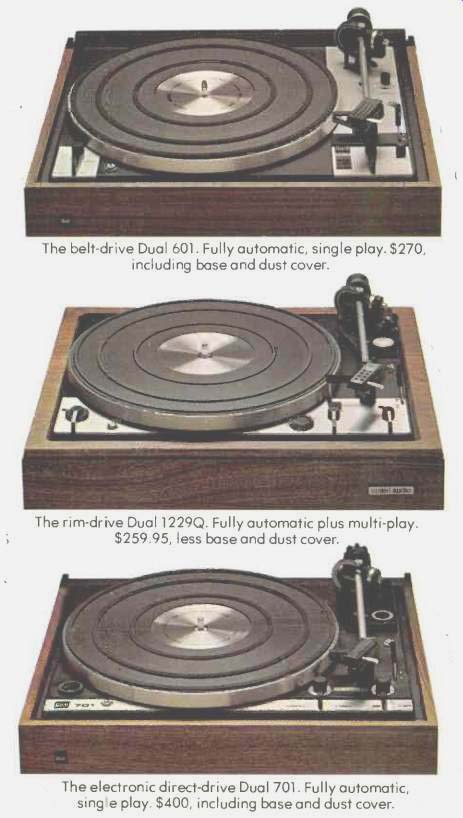Belt, rim, or direct drive?
Some reasonably unbiased comments from the people who make all three.

Manufacturers of turntables with just one type of drive system--belt,
rim, or direct-drive--naturally favor their own. Dual, however, makes
all three, and we fully agree with Julian Hirsch who said: "It would
make little difference if the platter were powered by well-disciplined
hamsters on a treadmill. It is the end result that counts" The belt-drive
system.
The main benefit of the belt-drive system is its effectiveness in filtering out motor vibration. It is a simple system that can be used with light duty motors and platters, and lends itself to low-cost manufacture.
The belt-driven Dual 601 is not compromised. It employs a high-torque 8-pole synchronous motor which drives a 4.5 pound dynamically-balanced platter, taking full advantage of a heavy platter's flywheel effect to filter out speed variations.
Thus, music lovers who prefer belt-drive single-play design can now enjoy the precision and performance of a Dual.
The rim-drive system.
In the rim-drive system, the platter is driven by an idler wheel which disengages when not in play. Since each part must be machined and carefully quality-controlled for perfect concentricity, this system is not inexpensive to make. When correctly made, it will perform not only precisely, but reliably and durably.
More audio experts-hifi editors, record reviewer engineers and music/equipment magazine readers- own and continue to purchase Duals (with this system) than any other make of quality turntable.
The direct-drive system.
In direct-drive systems, the motor rotates at record speed and drives the platter directly, without need for intermediate coupling. The result is a somewhat quieter and smoother platter rotation than is achieved with another system. But direct drive motors require a much more expensive technology.
The most advanced of all direct-drive systems is in the Dual 701. Among the exclusive features of its electronic motor: two sets of overlapping field coils that provide a totally gapless magnetic field that eliminates the successive pulses common to all other motor designs. Result: almost total elimination of wow and flutter.
How drive system performances compare.
As measured by the highly conservative European standard (DIN), the performances of the rim-drive 1229Q and the belt- drive 601 are identical: weighted rumble: -63dB; wow and flutter less than 0.06%. The direct-drive 701 does even better: weighted rumble, -70dB; wow and flutter, less than 0.03%.
Although the 701 specifications are more impressive than those of the 1229Q and 601, you are not likely to detect any difference unless your other components also meet the highest possible performance standards and you are an exceptionally critical listener.
So much for drive systems.
We now suggest you forget about differences among drive systems and simply decide which turntable best suits your requirements for total performance and convenience.
With a reasonable amount of bias, we also suggest your decision can be made quite happily from among the three types of Duals now available: Our automatic models with provision for multi-play, priced from $129.95 to $259.95. The belt-drive 601 at $270. Or the direct-drive 701 at $400.

top: The belt-drive Dual 601. Fully automatic, single play. $270, including
base and dust cover.
middle: The rim-drive Dual 1229Q. Fully automatic plus multi-play. $259.95, less base and dust cover.
above: The electronic direct-drive Dual 701. Fully automatic, singe play. $400, including base and dust cover.
United Audio Products
120 So. Columbus Ave., Mt. Vernon, N.Y. 10553
Exclusive U.S. Distribution Agency for Dual
--Dual--

(Source: Audio magazine, Apr. 1975 )
Also see: Dual turntables (May 1975)
Dual 701 turntable (Aug. 1975)
= = = =